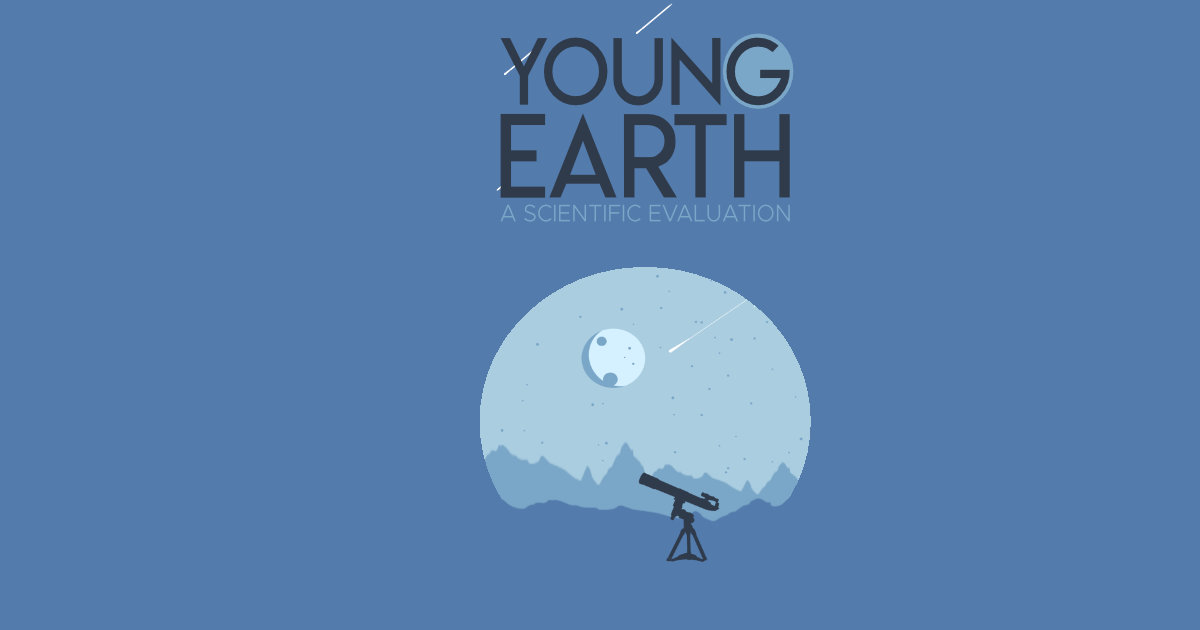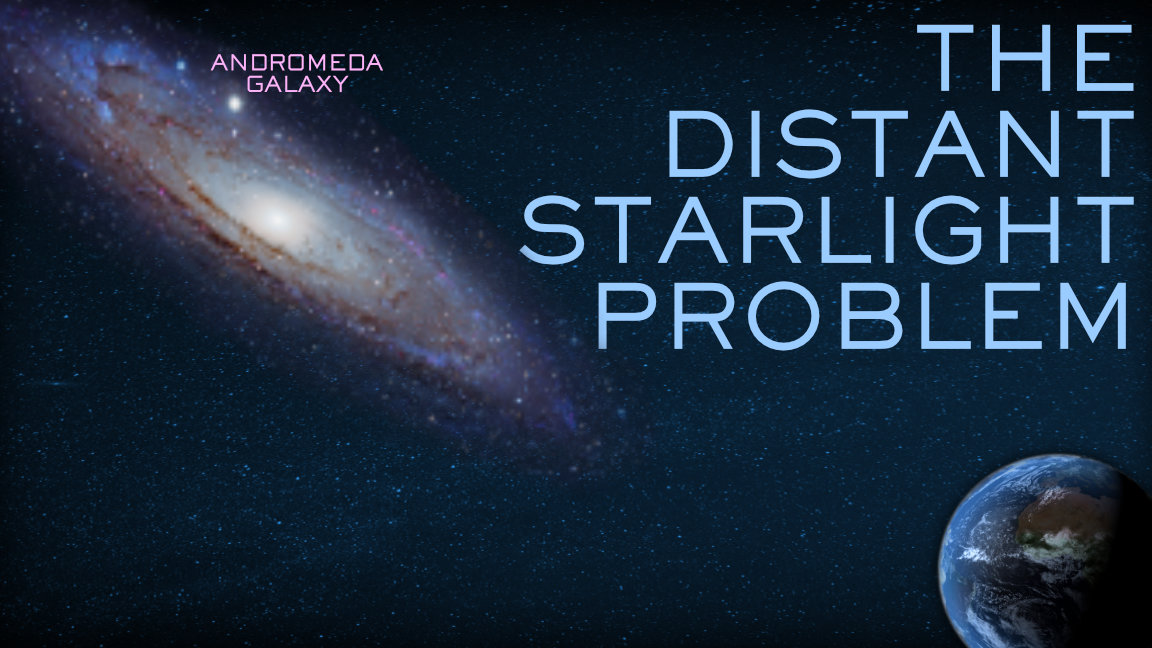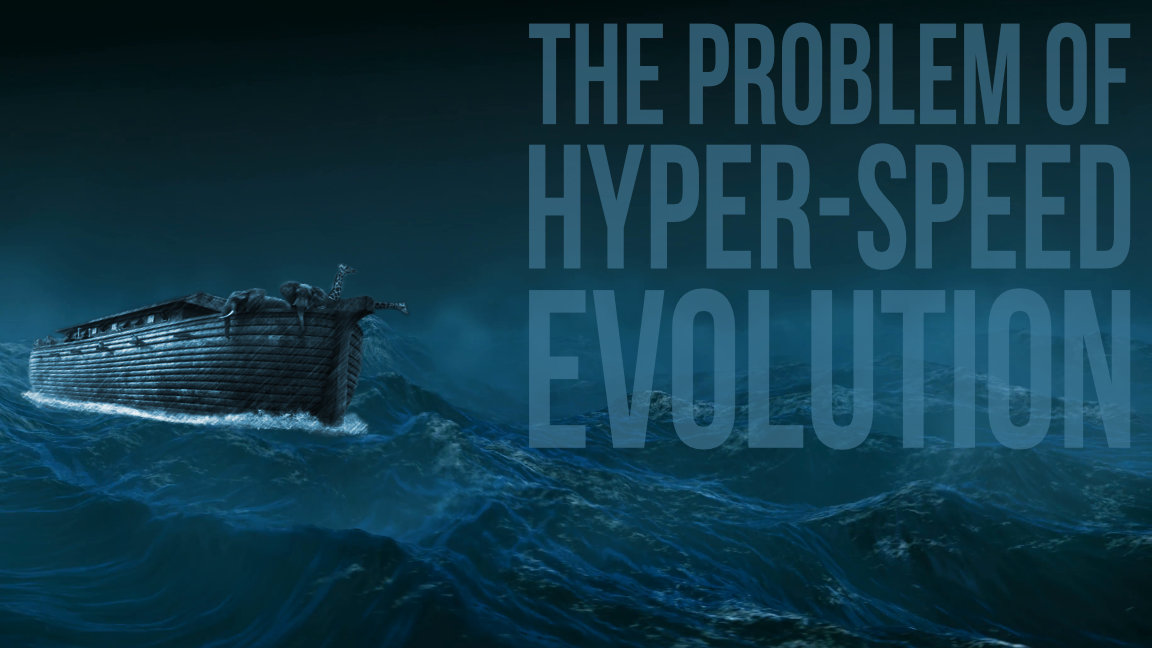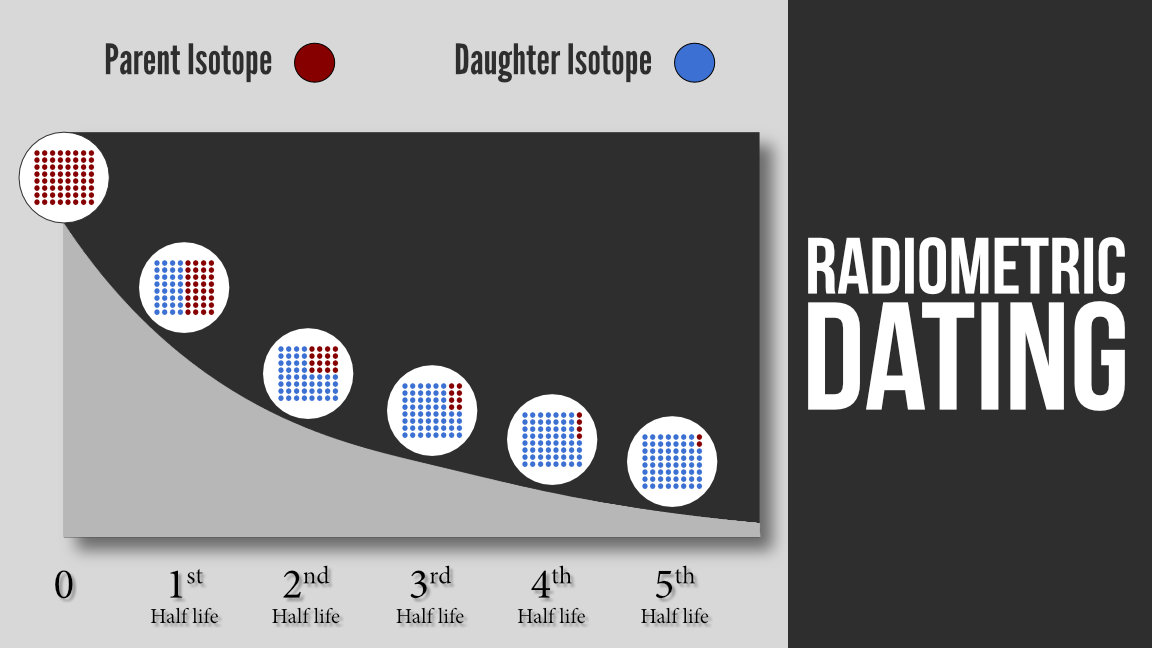 What is the scientific evidence for an old Earth and an even older Universe? To put this frankly, the evidence is overwhelming, and it comes from several independent fields of scientific study.
What is the scientific evidence for an old Earth and an even older Universe? To put this frankly, the evidence is overwhelming, and it comes from several independent fields of scientific study.
Evidence for an Old Earth and Ancient Universe
The distant starlight problem. Astronomers estimate that there are anywhere from 100-200 billion galaxies in the universe, and each galaxy averages roughly 100 billion stars. If all of these were within 6,000 light-years of the Planet Earth, we wouldn’t have a night sky due to being bombarded with this much light. Worse than that, the gravitational attraction would collapse the universe in on itself. Astronomers can accurate measure the distance of stars through several methods.
The Parallax Effect measures stars that are 3,500 light-years away by triangulating the distance from two different points in the Earth’s rotation around the sun.[1]
The Doppler Effect measures stars that are millions of light-years away by studying the expansion of exploding stars. Snoke writes, “Knowing the speed of the expansion, and assuming it is the same speed in all directions, one can measure the sideways expansion and thereby deduce the distance to the exploding object.”[2]
The Hubble Shift measures stars billions of light-years away based on their red-shift.
 These measurements indicate that we currently see stars and galaxies that are millions or even billions of light-years away. But this raises a major problem for YEC, because this would mean that light was travelling for millions or billions of years.[3] How do YECs respond to this difficulty?
These measurements indicate that we currently see stars and galaxies that are millions or even billions of light-years away. But this raises a major problem for YEC, because this would mean that light was travelling for millions or billions of years.[3] How do YECs respond to this difficulty?
RESPONSE #1. The speed of light was much faster in the past. Barry Setterfield argued that the speed of light was millions of times faster in the past, and consequently, the speed has decayed.[4]
Of course, we have no evidence for this occurring, and plenty of evidence that it didn’t occur. If the speed of light changed, then we would need to propose “changes in everything from the structure of atoms to the color of the sun to the cost of computer circuits.”[5] For instance, this would radically change nuclear fusion in stars, producing millions of times the energy output—hence incinerating the Earth. Changing the speed of light (c) would massively change energy (E) in Einstein’s famous theory of special relativity (E = mc2).
RESPONSE #2. Gravitational time dilation caused time to accelerate faster beyond the range of the Earth. Russell Humphreys created a model where the universe started as “ball of liquid water” that was “two light-years in diameter,” and it contained “all the mass of the universe.”[6] It transformed into a black hole, but then exploded into a white hole, propelling all of the mass in the universe away from the Earth at the center. From Day Two to Day Four, gravitational time dilation caused the time at the edge of the universe to move millions of times faster, while time on Earth stayed constant. This would give the allowed time for light to reach the Earth.
However, this “violates nearly every law of physics.”[7] Hugh Ross offers various critiques of this model. First, a ball of water of this size cannot physically exist, because gravity would create nuclear fusion long before it could be this size. Second, a black hole of this size would take way longer than several billion years to become a white hole. For comparison, Ross states that a black hole the size of Mount Everest would take 15 billion years to become a white hole. A black hole the size of two-light years would take far, far longer! Third, astronomers measure the speed of light across the universe, and these measurements are identical to one another. Even physicist John Hartnett—a fellow YEC—has criticized Humphreys’ model for this reason.[8] Fourth, the universe is “hotter” (and therefore older) the farther away it is. Fifth, the red shift of stars over 80 years would be more noticeable in a 10,000 year old universe than in a 13.7 billion year old universe. Yet we do not find the red shift changing this quickly. In fact, if Earth was in a gravity well, the light would be blue-shifted (coming closer), rather than red-shifted (moving farther away). Sixth, the Milky Way galaxy is not at the center of the universe but along the rim of the universe.
RESPONSE #3. The expansion of space explains how the speed of light was faster. John Hartnett created a model where the expansion of space explains how light could travel faster.[9] In his model, throughout the first three days of creation, clocks on Earth were 10 trillion times slower than clocks in the rest of the universe. On Day Four, Earth clocks sped up to the same speed as everywhere else. This means that the Earth was in a “time bubble” that was separate from the rest of the universe. Of course, cosmologists believe in an inflationary period in the early universe, but this is finely tuned to one part in 10120. The model that Hartnett proposes breaks this finely tuned constant.
RESPONSE #4. God started the light particles in transit 10,000 light-years away. Duane Gish believed that God started photons of light in transit to the Earth, roughly 10,000 light-years away.[10] This raises theological problems—namely, God is deceiving us. That is, we currently observe stars that never existed—only the photons from 10,000 light-years away.
RESPONSE #5. Light moves infinitely fast in one direction. Jason Lisle[11] correctly notes that it’s impossible to have perfectly synchronized clocks in two places at once, because clocks in motion measure time at different rates (based on Einstein’s theory of relativity). Therefore, scientists measure the speed of light from the same clock, sending out light to a distant mirror and measuring the time of it round trip. Lisle states that we are merely assuming that light moves at the same speed in both directions. Perhaps, he argues, light travels nearly infinitely fast in one direction, and half as fast on the return trip. Earth, he argues, has a special place in the universe, because the one-directional speed of light would travel there almost instantaneously from distant stars. Hence, the light from distant stars travelled almost instantly to Earth on Day Four (Gen. 1:14).
There are a few problems with this view. First, fellow YECs (like Jonathan Sarfati) have called this theory “ad hoc,” because it makes unjustified assumptions.[12] Second, this theory is untestable, even according to Lisle who writes, “It is not a scientific model; it does not make testable predictions. It is a convention of measurement and cannot be falsified any more than the metric system can be falsified.” Third, it would require a geocentric gravitational field (beyond the one normal one created by the mass of the Earth) to carry light to the Earth, which we do not detect.
Varves. Varves are couplets (or bands) of coarse and fine strata in rocks. In the spring and summer, coarse sediment forms from the movement of water, and in the winter, fine sediment forms above this coarse sediment. Counting the number of varves in a rock is like counting the rings inside of a tree. They give us the years that it took to create the sedimentary rock layer. Some of these rock layers reveal hundreds of thousands of varves.
Lake Suigetsu in Japan. Geologists counted 100,000 varves, and when they ran Carbon-14 dating on organic material in these various strata, this independently aligned with the years extrapolated from counting the varves.[13]
The Green River Formation. Currently, the Green River brings coarse, sandy sediment during the spring and summer seasons, and this material settles and solidifies during the winter season. The following spring, new sediment adds to the formation. The Green River Formation stretches over 40,000 square miles in Wyoming, Colorado, and Utah, and contains somewhere between 4 million to 7.5 million varves (couplets of light and dark sedimentary rock). The top of this geological column is 2,500 feet, and it sits above another 25,000 feet of sedimentary rock.
YECs claim that Noah’s Flood created these sedimentary layers. However, this would require creating 2.5 couplets per second over the course of a year. Moreover, within the varves, geologists have identified bird nests, bird eggs, bird feces, and bird footprints. Again, this would require all of these varves to be created while birds nested, gave birth, and walked on the surface of this sedimentary rock. None of these features can be explained by appealing to a global flood.[14]
Ice cores in Greenland and Antarctica. The winter and summer layers form couplets in these ice cores. These layers date back 160,000 years.[15] The volcanic eruption of Vesuvius (2,000 years ago) fits within this dating.
The dividing of the continents. When we look at the continents, we observe that these continents fit together like a jigsaw puzzle. This is because our current continents originally spread apart from one supercontinent called Pangea (“one land”). The continents continue to move, but only 2-5 centimeters per year. Thus this would have taken millions of years for the continents to spread apart. Again, YECs appeal to Noah’s Flood for the shifting of the continents.
Coral reefs. Living organisms called corals secrete calcium carbonate to create coral reefs. These only grow ~8 millimeters (or .3 inches) per year, and yet, some coral reefs are nearly a mile deep (e.g. Eniwetok is 4,610 feet deep).[16] Recent drilling has shown that parts are between 600,000 and 1,000,000 years old.[17]
The problem of hyper-speed evolution. The fossil record reveals roughly half a billion distinct species. Of these, roughly five million species exist today.[18] According the most generous YEC estimates, roughly 30,000 species could’ve lived on the Ark.[19] Since God ceased creating life on the seventh day, this would mean that the process of evolution would’ve needed to create five million species from these original 30,000—in only 4,000 years! Hugh Ross refers to this as “Young-Earth Darwinism,”[20] which exceeds any proposed account from naturalistic evolutionary theory!
Radiometric dating. Scientists measure the half-life decay of radioactive material in rocks. The atoms of the original element (the parent element) decay into atoms of lighter elements (the daughter element). Time can be measured by the decay of the original element into the daughter element, which have individual half-lives to measure their decay. These decay at the same rate even if they are exposed to “heat, cold, pressure, vacuum, acceleration, and strong chemical reactions.”[21]
There are roughly 40 techniques that each use a different radioactive element.[22] All generally agree that certain rocks on Earth are billions of years old. In order to overturn this evidence, all 40 of their half-lives would need to be changing—synchronized with one another. We find none of the younger isotopes on Earth.[23] However, astronomers do detect these radiometric elements in stars younger than our sun. Dr. Roger Wiens (who worked at Caltech’s Division of Geological & Planetary Sciences) writes, “Over a thousand papers on radiometric dating were published in scientifically recognized journals in the last year, and hundreds of thousands of dates have been published in the last 50 years. Essentially all of these strongly favor an old Earth.”[24]
RESPONSE #1. The decay rate was faster earlier in history. This is unfounded. For one, astronomers directly observe radiometric elements as they existed billions of years ago.[25] Moreover, a faster decay rate would complete obliterate life on Earth. For instance, the weak-nuclear force coupling constant would destroy most elements on the periodic table, leaving only hydrogen.[26]
RESPONSE #2. The decay of helium leads to contradictory results for zircon crystals. YECs argue that if the Earth was billions of years old, then helium would’ve diffused out of these crystals, and also, there is too little helium in the atmosphere. However, because helium is so pervasive, scientists do not use it as a time marker, because it moves in and out of rocks and our atmosphere. However, argon-40 is ten times heavier than helium, and doesn’t escape the Earth’s atmosphere as helium does. The amount of argon-40 is consistent with a 4.5 billion year old planet.
Testing zircon crystals with lead gives consistent results. Lead comes from radiometric decay. Ross writes, “The end product of uranium-238 decay (half-life = 4.46 billion years) is lead-206. For uranium-235 (half-life = 0.704 billion years), the end product is lead-207, and for thorium-232 (half-life = 14.1 billion years), it’s lead-208. Therefore, any sample that contains these uranium and thorium isotopes and the three different lead isotope end products gives an investigator three independent tools for determining its age.”[27] When we study Zircon crystals with uranium, thorium, and lead, these all date to 4-4.4 billion years old.[28]
RESPONSE #3. There are examples of radiometric dating that have shown the measurement is flawed. YECs often appeal to rocks formed from Mount St. Helens in the eruption of the 1980s, which dated to millions of years old. This doesn’t invalidate radiometric dating. To begin with, most rocks (over 99%) were not created by catastrophic volcanic eruptions: Sandstones, shales, and limestones are not created this way. Second, in this example, the rocks were measured using potassium 40-argon 40 (K-Ar) testing. This is the wrong test for dating a young rock. Remember, geologists use 40 radiometric dating methods, which complement one another independently. Measuring different isotopes brings more clarity—not less. Finally, the size of the sample and the purity of the sample affects the results.
To summarize, we agree that radiometric measurements do not work provided that (1) you use the wrong dating technique, (2) you use small sample sizes, (3) you have impure samples, and (4) you ignore the uniformity of the method across the scope of 40 independent techniques. In other words, this method doesn’t work if your work doesn’t follow the method!
Are we merely assuming uniformitarianism?
Uniformitarianism is the belief that the “the present is the key to the past.” But YECs argue that many catastrophic events occurred in the world, according to the Bible (e.g. the Global Flood). Since the naturalistic scientist denies God’s intervention, then it shouldn’t surprise us to discover them denying a Young Earth.[29]
It’s true that we shouldn’t assume that everything has always been the same. However, the burden of proof rests on the person claiming otherwise. The Flood cannot account for the fossils being buried in exactly the same way.
If scientists discovered a catastrophic event, they would likely investigate it. For instance, Luis Alvarez had a theory that a meteor struck Earth, catastrophically killing off the dinosaurs. He based this off of a thin layer of rare iridium in the geological strata, which lined up with the extinction of the dinosaurs (~65 mya). Later, scientists confirmed this theory, when they found the crater of the meteor in Mexico’s Yucatan Peninsula.
Did God create the universe with the appearance of age?
In 1857, Philip Gosse was a British biologist, as well as a committed Christian. He argued that God created the world with the appearance of age—even saying that trees would have rings in them.[30] Many YECs have followed in his footsteps:
Theologian Gary North: “The Bible’s account of the chronology of creation points to an illusion.… The seeming age of the stars is an illusion.… Either the constancy of the speed of light is an illusion, or the size of the universe is an illusion, or else the physical events that we hypothesize to explain the visible changes in light or radiation are false inferences.”[31]
John Whitcomb: “There could be no genuine creation of any kind without an initial appearance of age inherent in it.… If God exists!—then there is no reason why He could not, in full conformity with His character of truth, create a whole universe full-grown.”[32]
Dennis Petersen: “If your God could create sources of star light, do you think He might be able to create the light beams to instantly appear on the Earth?”[33]
Kurt Wise: “As I shared with my professors years ago when I was in college, if all the evidence in the universe turned against creationism, I would be the first to admit it, but I would still be a creationist because that is what the Word of God seems to indicate. Here I must stand.”[34]
To take a key example, YECs state that Adam and Eve were created to appear as adult humans—even though they didn’t live that long. Similarly, God made the universe with an appearance of age. But there’s many problems with this view.
For one, the analogy of Adam and Eve breaks down. A better analogy would be if God gave Adam and Eve implanted memories of growing up to maturity, scar tissue on their skin, and belly buttons![35] The presence of a belly button would have nothing to do with Adam’s age; instead, it would imply that he had a physical birth. This is what we see in the natural sciences: varves of sedimentary rock, hundreds of thousands of ice cores, exploding supernovae, etc. It’s one thing for God to create rocks, ice, and stars, but why go through an elaborate process of making them look like they were created through a process?
Second, this theory admits that the universe looks old. Think about it. YECs would never make such an argument if the science was truly on their side. It isn’t that they are trying to explain the scientific data by appealing to a “mature creation,” but rather, they are trying to explain it away.
Third, this theory is unfalsifiable. Thus, Ross writes, “If a proposition cannot be falsified, neither can it be verified. In this case, no evidence could count either for or against the universe’s age.”[36] If YECs appeal to an “appear of age” or a “mature creation,” then they have effectively waved the white flag, admitting that there is no scientific evidence for a Young Earth!
Fourth, this theory implies that God is a deceiver. Paul writes that people are “without excuse” for looking at nature—not Scripture (Rom. 1:20).
To summarize, YECs share a common philosophical approach with atheists. This sounds strange, but it’s true. Richard Dawkins writes, “Biology is the study of complicated things that give the appearance of having been designed for a purpose.”[37] Skeptic Michael Shermer writes, “The design inference comes naturally. The reason people think that a Designer created the world is because it looks designed. I think we should quit tiptoeing around this inference and admit that life looks designed because it was: from the bottom up, by evolution.”[38] Similarly, YECs approach the sciences with the view that the Earth only appears old.
Is this a global conspiracy?
Many Christians have believed to a conspiratorial view of modern scientists. However, there is one factor that should get them to question this perspective: money. If YEC could account for natural events better than the current paradigm, this would surely be lucrative, and investors would race adopt their views.
Consider one example. Oil is usually found in deserts or arctic areas. This is because the movement of plate tectonics determines “the location of oil and gas reservoirs and [this] is the best key we have to understanding why deserts and arctic areas seem to hold the largest hydrocarbon reserves on earth.” The shifting of plate tectonics created “pressure cookers” to turn organic matter into oil and gas.[39]
Yet YECs state that the continents moved because of the Flood, rather than the slow shifting of plate tectonics. If the YEC model was correct, scientists would quickly adopt it. Why? Because it would create profit! David Snoke writes, “If young-earth science made better predictions than old-earth science of where to find oil, I am convinced that the industry would embrace it in an instant.”[40]
Furthermore, scientists have observed an Old Earth in interdisciplinary fields of science (e.g. animal biology, marine biology, chemistry, physics, geology, etc.). If there is a conspiracy in modern science, it would need to transcend several different scientific disciplines. Therefore, in order to defeat this evidence, the Young Earth creationist would need to argue against each and every scientific field, which seems like an insuperable task. If even one of these evidences is true, the Young Earth position would collapse.
Is there scientific evidence for a Young Earth?
YECs offer many different evidences for a Young Earth. Yet, one by one, these have proven to be false.
Continental erosion. The continents erode at 0.05 millimeters per year. Looking backward, this would mean that the oceans would have submerged the continents 16 million years ago.
However, erosion isn’t the only factor. It ignores that “lava flows, delta and continental shelf buildup (from eroded material), coral reef buildup, and uplift from colliding tectonic plates occur at rates roughly equivalent to, and in some cases far exceeding, the erosion rate.”[41] For instance, the Himalayas rise by 15 millimeters per year from the shifting of the tectonic plates. Volcanic lava has created several square miles of land in Hawaii just since 1959. In fact, this argument backfires, because the surface of the planet went from 100% water to 71% water. This means that these mechanisms increased the continents over roughly three billion years.
Lunar dust on the moon. Geophysicist Hans Pettersson calculated that 14 million tons of space dust landed on the Earth per year. After analyzing the differences between the gravity and mass of the Earth and the moon, he calculated that the moon should have 35 feet of meteorite dust if it was really 4.5 billion years old.[42] Instead, it only has fractions of an inch to three inches at the very most.
Yet this argument has been abandoned by modern YECs in recent years.[43] In reality, the Earth only gets 40,000 tons of meteorite dust per year, and the moon only gets 3,000 tons, which incidentally predicts 1.2 inches of dust for a 4.5 billion year old moon.[44] This, incidentally, is exactly what we observe.
Dinosaur and human footprints have been found alongside one another.[45] YECs once held that the “Paluxy footprints” demonstrated that humans and dinosaurs lived at the same time.
However, scientists have identified these “human” footprints as actually belonging to tridactyls—three-toed dinosaurs. The footprints are too far apart to be from the stride of a human, and some of the prints are two large to be human. Moreover, the prints have dinosaur features such as claws, V-shaped heels, etc. The trail of these prints often blend into easily identifiable tridactyl prints. Many YECs have stopped using these arguments—most notably John Morris, the son of the famed YEC Henry Morris.[46]
Comets disintegrate within a few thousand years. The orbit of a comet around the Sun burns away much of its mass, giving it a short lifespan. Thus, YECs hold that this proves that comets much be young in age; otherwise, they would’ve been incinerated by now. However, Hailey’s comet could survive 500 revolutions around the sun, and it passes the sun every 76 years. Therefore, it is likely 40,000 years old. Other comets (e.g. Kohoutek, Pons-Brooks, Griggs-Mellish, etc.) only orbit the sun every three million years.[47]
Soft tissue and biomolecules exist in dinosaur bones. If these are really millions of years old, then they would’ve decayed by now.
The decay of soft tissue depends on its exposure to bacteria and oxygen, but fossils often have “exceptional preservation” including “feathers, hair, color or color patterns, embryonic soft tissues, muscle tissue and/or internal organs, and cellular structure.”[48] The tissue found in dinosaur bones fits this exact scenario. In order to transform the mineralized material, scientists needed to soak the material in diluted acid to make it elastic and soft.[49] Furthermore, the supposed blood cells in the bone samples merely resembled blood cells.[50]
Conclusion
It’s nearly impossible to respond to the rapid-fire arguments of YECs. Some organizations employ dozens of PhD’s to research apparent problems with an Old Earth, and some websites boast of over 10,000 individual articles. The problem isn’t that the evidence for a Young Earth is good; it isn’t. The problem is that the claims are so voluminous that it’s hard to answer so many.
Scientists have repeatedly disproven YEC claims in one case after another. Yet, when one is disproven, another surfaces ad infinitum. One author has compared this to the game of “whack-a-mole,” where it’s simply impossible to respond to so many claims. We might compare it to a person who gives twenty arguments against the resurrection of Jesus in ten minutes, but then expects you to answer all twenty in the same amount of time! Debaters refer to this as the “machine gun” tactic. It’s simply impossible to answer accusations as quickly as the person can make them.
Many YECs admit quite plainly that the natural sciences point to an extremely ancient universe. We have great admiration for the intellectual integrity of Paul Nelson and John Mark Reynolds, when they state,
Natural science at the moment seems to overwhelmingly point to an old cosmos. Though creationist scientists have suggested some evidences for a recent cosmos, none are widely accepted as true. It is safe to say that most recent creationists are motivated by religious concerns.[51]
As it is now interpreted, the data are mostly against us. Well and good. We take this seriously. Eventually, failure to deal with that data in a recent creationist scientific theory would be sufficient reason to give up the project. We think, however, that progress is being made… Recent creationists should humbly agree that their view is, at the moment, implausible on purely scientific grounds.[52]
Those who believe in an “apparent age” or a “mature creation” also admit that the scientific evidence strongly favors an Old Earth; otherwise, they would never make such a claim.
YEC creates unnecessary barriers for belief. To put this frankly, this perspective is embarrassing to Christianity. To be clear, we are not saying that people are embarrassing. YECs are brothers and sisters in Christ, and many are faithful and loving servants of Jesus. Rather, we are saying that this perspective is an embarrassment.
If non-Christians see Christians as being undependable when we interpret scientific reality, then why would they trust us when we share about spiritual reality?[53] If you are a YEC, we would implore you to at least be open to reconsidering your view. The souls of lost people hang in the balance! Are you so certain about your perspective that you are willing to risk creating unnecessary barriers for non-Christians? Are you so certain about your interpretation of Genesis 1 that you would risk creating unnecessary barriers for belief?
Instead of dogmatism on this issue, we suggest another approach. We should hold firm to what the Bible says clearly, but we should be open to various views on matters that are unclear.
Further Reading
J.P. Moreland, Three Views on Creation and Evolution (Grand Rapids, MI: Zondervan, 1999).
Hugh Ross, A Matter of Days (Colorado Springs, CO: NavPress, 2004).
Hugh Ross, Creation and Time: A Biblical and Scientific Perspective on the Creation-Date Controversy (Colorado Springs: NavPress, 1994).
C. John Collins, Science & Faith: Friends or Foes? (Wheaton: Crossway, 2003).
[1] David Snoke, A Biblical Case for an Old Earth (Grand Rapids, MI: Baker, 2006), p.27.
[2] David Snoke, A Biblical Case for an Old Earth (Grand Rapids, MI: Baker, 2006), p.27.
[3] Take the Andromeda galaxy for example. The images we see come from light particles that have been travelling for two million years, because it is two million light-years away.
[4] Barry Setterfield and Trevor Norman, “The Atomic Constants, Light, and Time” (1987).
[5] David Snoke, A Biblical Case for an Old Earth (Grand Rapids, MI: Baker, 2006), p.
[6] Russell Humphreys, Starlight and Time: Solving the Puzzle of Distant Starlight in a Young Universe (Green Forest, AZ: Master Books, 1994), p.32.
[7] Hugh Ross, A Matter of Days (Colorado Springs, CO: NavPress, 2004), p.167-169.
[8] John G. Hartnett, “Look-Back Time in Our Galactic Neighborhood Leads to a New Cosmology,” TJ: The In-Depth Journal of Creation 17, no. 1 (2003), 73-79.
[9] John G. Hartnett, “A New Cosmology: Solution to the Starlight Travel Time Problem,” TJ: The In-Depth Journal of Creation 17, no. 2 (2003), 98-102.
John Hartnett, New Evidence: We Really Are at the Centre of the Universe, Journal of Creation 18 (1): 9, 2004.
[10] “Is Creationism Science?” A Debate between Duane Gish & Frank Zindler (January 11, 1990).
[11] Jason Lisle, “Anisotropic Synchrony Convention—A Solution to the Distant Starlight Problem” Answers Research Journal 3 (2010): 191-207.
[12] Jonathan Sarfati, “Anisotropy Synchrony Convention” (May 12, 2012). https://creation.com/asc-cosmology
[13] Gregg Davidson and Ken Wolgemuth. “Christian Geologists on Noah’s Flood: Biblical and Scientific Shortcomings of Flood Geology.” The BioLogos Foundation (Grand Rapids, MI, 2010).
[14] Perry G. Phillips, Varves: Layered Sediments as Evidence for an Old Earth.
[15] Roger Wiens, “Radiometric Dating: A Christian Perspective” (p.17).
[16] Perry G. Phillips, “Coral Reefs: Indicators of an Old Earth.”
[17] David Snoke, A Biblical Case for an Old Earth (Grand Rapids, MI: Baker, 2006), p.33.
[18] Paul R. Ehrlich and Anne H. Ehrlich, Extinction: The Causes and Consequences of the Disappearance of Species (New York: Ballantine, 1981), p. 33. Gary K. Meffe, C. Ronald Carroll, and contributors, Principles of Conservation Biology, 2d ed. (Sunderland, MA: Sinauer Associates, 1997), pp. 91-93. Cited in Hugh Ross, A Matter of Days (Colorado Springs, CO: NavPress, 2004), p.123.
[19] John C. Whitcomb and Henry M. Morris, The Genesis Flood: The Biblical Record and Its Scientific Applications (Philadelphia: Presbyterian and Reformed Publishing Co., 1961), pp.66-69.
[20] Hugh Ross, A Matter of Days (Colorado Springs, CO: NavPress, 2004), p.121-130.
[21] Roger Wiens, “Radiometric Dating: A Christian Perspective” (p.2).
[22] Roger Wiens, “Radiometric Dating: A Christian Perspective” (p.3).
[23] Ross writes, “Geologists and geophysicists find no neptunium-237 (half-life = 2.14 million years), no aluminum-26 (half-life = 720,000 years), no calcium-41 (half-life = 103,000 years), no iodine-129 (half-life = 17 million years), no technetium-98 (half-life = 4.2 million years), and no plutonium-244 (half-life = 82 million years). The lack of these isotopes in Earth, on the Sun, or in meteorites persuades scientists that Earth and the solar system must be older than a billion years (15 half-lives x 83 million = 1,245 million years).” Hugh Ross, A Matter of Days (Colorado Springs, CO: NavPress, 2004), p.176.
[24] Roger Wiens, “Radiometric Dating: A Christian Perspective” (p.19).
[25] Hugh Ross, A Matter of Days (Colorado Springs, CO: NavPress, 2004), p.178-179.
[26] Hugh Ross, A Matter of Days (Colorado Springs, CO: NavPress, 2004), p.179.
[27] Hugh Ross, A Matter of Days (Colorado Springs, CO: NavPress, 2004), p.180.
[28] Hugh Ross, A Matter of Days (Colorado Springs, CO: NavPress, 2004), p.181.
[29] Citing 2 Peter 3:4, Sarfati writes, “Peter reveals the huge flaw of the uniformitarian scoffers: they are ‘willingly ignorant’ of special creation by God and a cataclysmic globe-covering (and fossil-forming) Flood.” He continues, “This automatically excludes acts of creation and the global Flood, neither of which are occurring today.” Jonathan Sarfati, The Genesis Account (Powder Springs, GA: Creation Book Publishers, 2015), Kindle locs., 3842, 4760.
[30] Philip Henry Gosse, Omphalos: An Attempt to Untie the Geological Knot (London: John Van Voorst, Paternoster Row, 1857), pp.341-351.
[31] Gary North, The Dominion Covenant: Genesis (Tyler, TX: Institute for Christian Economics, 1987), pp.254-255.
[32] John C. Whitcomb Jr., The Early Earth (Grand Rapids, MI: Baker, 1972), p.30.
[33] Dennis R. Petersen, Unlocking the Mysteries of Creation (South Lake Tahoe, CA: Christian Equippers International, 1986), p. 23.
[34] Kurt Wise, In Six Days: Why Fifty Scientists Choose to Believe in Creation, John F. Ashton, ed. (Green Forest: Master Books, 2001), Kindle location 5049-51.
[35] David Snoke, A Biblical Case for an Old Earth (Grand Rapids, MI: Baker, 2006), p.33.
[36] Hugh Ross, A Matter of Days (Colorado Springs, CO: NavPress, 2004), p.86.
[37] Richard Dawkins, The Blind Watchmaker (New York: W.W. Norton & Company, 1986), p.1.
[38] Michael Shermer, Why Darwin Matters: The Case against Intelligent Design (New York: Times, 2006), p. 65.
[39] Roger Anderson, “Why is oil usually found in deserts and arctic areas?” Scientific American (January 16, 2006.
[40] David Snoke, A Biblical Case for an Old Earth (Grand Rapids, MI: Baker, 2006), p.42.
[41] Hugh Ross, A Matter of Days (Colorado Springs, CO: NavPress, 2004), p.186.
[42] Hans Pettersson, “Cosmic Spherules and Meteoritic Dust,” Scientific American 202 (February 1960): 123-132.
[43] Andrew A. Snelling and D. E. Rush, “Moon Dust and the Age of the Solar System,” Creation Ex Nihilo Technical Journal 7 (1993): 2-42.
[44] Hugh Ross, A Matter of Days (Colorado Springs, CO: NavPress, 2004), p.188.
[45] Henry M. Morris, and John C. Whitcomb, The Genesis Flood (Grand Rapids, MI: Baker, 1961), pp. 173-175; Carl E. Baugh and Clifford A. Wilson, Dinosaur: Scientific Evidence That Dinosaurs and Men Walked Together (Orange, CA: Promise, 1987).
[46] John D. Morris, “The Paluxy Mystery,” Impact, no. 151 (January 1986): i-iv.
[47] Hugh Ross, A Matter of Days (Colorado Springs, CO: NavPress, 2004), p.203.
[48] Mary H. Schweitzer et al., “Soft-Tissue Vessels and Cellular Preservation in Tyrannosaurus rex,” Science 307 (March 25, 2005): 1955.
[49] Mary H. Schweitzer et al., “Soft Tissue Vessels and Cellular Preservation in i> Tyrannosaurus rex,” Science 307 (March 25, 2005): 1954.
[50] Erik Stokstad, “Tyrannosaurus rex Soft Tissue Raises Tantalizing Prospects,” Science 307 (March 25, 2005): 1852.
[51] J.P. Moreland and John Mark Reynolds Three Views on Creation and Evolution (Grand Rapids, MI: Zondervan Pub., 1999), p.49.
[52] J.P. Moreland and John Mark Reynolds Three Views on Creation and Evolution (Grand Rapids, MI: Zondervan Pub., 1999), p.51.
[53] I am indebted to Hugh Ross for this observation. Hugh Ross, A Matter of Days (Colorado Springs, CO: NavPress, 2004), p.173.





